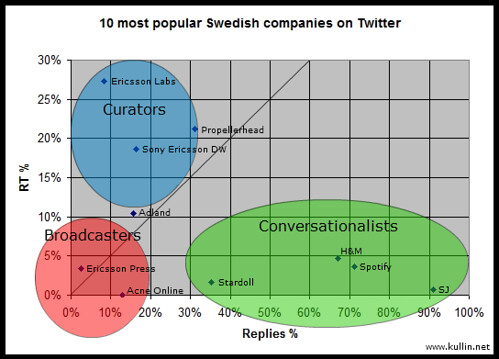Yesterday I published a short white paper on how Swedish businesses use Twitter for their official corporate accounts. I looked at more than 350 corporate accounts and especially at the ones with most followers. These top accounts behaved in very different ways and I sorted them into three different categories, labelled Broadcasters, Curators and Conversationalists.
Broadcasters
Mainly use Twitter to publish messages, often with automated feeds from other sources, such as Facebook or press releases. Rarely engage in conversations, answer questions or retweet other users’ tweets. Low share of retweets and replies.
Curators
Actively filter and select the most interesting content on certain topics and share with their followers. Are thought leaders who mix their own expertise with retweets of other sources in the community. High share of retweets.
Conversationalists
High degree of interactivity with other users. Often use Twitter as a tool to help customers, answer questions and engage with the community. High share of replies.
Depending on which of these categories a corporate account falls into, the way the company staffs its Twitter account also varies. I would imagine that it doesn’t take a lot to become a Broadcaster, just add a number of your own sources that automatically feeds into Twitter, plus the occasional manual entries and you are all set to go. To become a Curator, you would possibly need a person or a team that are some kind of thought leaders, who are interested in the company, the products and the industry. People who read a lot, who like to be in the forefront and lead the way forward. For Conversationalists you typically need a team that can be online constantly and are able to network within the organization so that they quickly can find the answers to customers’ questions.
What other skills do you think are necessary for each of these types of Twitter profiles?
